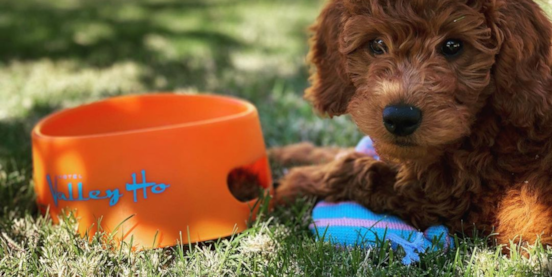Meet The Black Cockapoo: Pictures, Color Fading +More
Black Cockapoos are instantly recognizable for their deep, glossy coats and bright, intelligent expressions. They carry the same affectionate nature that defines all Cockapoos but bring a certain elegance that sets them apart. The contrast of their dark coat with... Read More
Are Cockapoos Hypoallergenic? Do Cockapoos Shed?
Cockapoos have earned a strong reputation as allergy-friendly dogs, often listed among the breeds that shed the least. Their soft, often curly coats come from their Poodle parent, while their warmth and adaptability trace back to the Cocker Spaniel. Families looking... Read More
Do Cockapoos Bark a Lot?
Spend enough time around Cockapoos, and you start to understand how they use their voice. They don’t bark to fill silence or to get attention for no reason. They bark because something catches their attention. Sometimes it’s a sound outside, a knock... Read More
Are Cockapoo Good Dogs?
Cockapoos have become one of the most loved mixed breeds in America, and it’s easy to see why. With their expressive faces, soft coats, and cheerful personalities, they win people over in an instant. But for anyone thinking about bringing one home, a fair... Read More
How Long Do Cockapoos Live? Cockapoo Lifespan – A Guide to Longevity
Cockapoos, one of America’s most favorite companion dogs, come from a mix of the Cocker Spaniel and the Miniature or Toy Poodle. The mix has gained a loyal following over the years, and it’s easy to see why. Cockapoos bring a steady, loving nature into... Read More
Top 12 Pros and Cons of Owning a Cockapoo
If you’ve ever met a Cockapoo, you know why people fall for them so easily. They have that unmistakable mix of intelligence and heart. They have alert eyes that seem to catch everything and a temperament that leans toward friendliness almost by default.
The... Read More
Best Mini Goldendoodle Haircuts
If you’re searching for mini goldendoodle haircuts, you’re probably looking for something simple: clear examples, style names that actually make sense, and guidance on choosing the right cut for your dog’s coat. Mini Goldendoodle puppies come... Read More
Top Mini Goldendoodle Breeders in the USA
Welcome to Premier Pups, home to the most reputable Mini Goldendoodle breeders in the United States. Together with our dedicated breeder partners, we’ve built a process centered on health, happiness, and genuine love for the breed. Every puppy is raised with... Read More
Top Mini Goldendoodle Name Ideas
Choosing the perfect name for your Mini Goldendoodle is one of the most exciting parts of bringing your new puppy home. It’s the first word they’ll learn, the sound that’ll make their tail wag, and the name you’ll call out every day for... Read More
Mini Goldendoodle Training: The Complete 2025 Guide
Bringing home a Mini Goldendoodle is an exciting experience, and if you’ve ever met one, you already know why. They’re friendly, intelligent, and full of personality. But as adorable as they are, these little bundles of energy also need proper guidance... Read More
How Much Does a Mini Goldendoodle Cost?
When you first start looking into getting a Mini Goldendoodle, one of the first questions that comes up is, “How much does a Mini Goldendoodle cost?” The answer isn’t simple, because prices can vary a lot, but understanding why they vary makes... Read More
Goldendoodle Size Guide: Generations, Growth Charts & More
Planning on getting a Goldendoodle puppy and don’t know what to expect in terms of size? Or are you wondering how big your Goldendoodle puppy will get?
Goldendoodles come in every size imaginable - from tiny lap dogs to big, adorable teddy bears. You’ll... Read More
15 Ways Premier Pups Supports You From First Questions to Life After Reservation
The search for a puppy today begins online, but the experience that follows isn’t always predictable. Some platforms offer minimal information. Others leave families managing logistics and health questions on their own. In a space where every decision matters,... Read More
Puppy Scams Online: Red Flags and How to Protect Yourself
The search for a new puppy is meant to be joyful. Families picture wagging tails, playful paws, and the beginning of a bond that will last for years. But alongside the excitement, there's a growing risk many don’t expect: online puppy scams.
In recent... Read More
How Is Premier Pups Different from Other Online Puppy-Selling Businesses?
The online puppy industry is booming, but so are the concerns that come with it. Families eager to reserve often find themselves navigating a maze of vague guarantees, glossy websites, and questions about where puppies really come from. Reports from the ASPCA and... Read More
A Step-By-Step Guide to Reserving a Puppy Through Premier Pups
Reserving a puppy is an exciting milestone, but it can also raise questions. What steps do you need to take? How does the reservation process work? And what should you expect along the way? At Premier Pups, the goal is to make this journey simple, transparent, and... Read More
Inside the First 8 Weeks of a Premier Pups Puppy’s Life
Welcoming a puppy into the family is an unforgettable moment, but many new owners wonder what life looks like for their puppy before reservation day. How are puppies cared for in those crucial first weeks? What milestones do they reach while they’re still with... Read More
Premier Pups Reviews: Verified Reservation Stories
Reserving a puppy is a big decision, and it’s natural to have questions. Is this the right place? Can I trust the process? Will my puppy be healthy and happy when they come home? Families who come to Premier Pups often share the same worries at first, and... Read More
Premier Pups Breeders: The People Behind the Promise
Behind every healthy, happy puppy is a breeder who did things the right way from the very beginning. At Premier Pups, our breeders are our partners in the process. We’ve built long-term relationships with a trusted network of professionals who share our values:... Read More
Premier Pups 10-Year Health Guarantee Explained
Good health is something you plan for. At Premier Pups, we’ve built our 10-Year Health Guarantee to reflect that. Each of our puppies is examined nose to tail by a licensed veterinarian before reservation, kept current on vaccinations and deworming, and monitored... Read More





















